Best
Flute
-
Overall: Produces clear and bright sound for developing good tone and technique
-
Best Feature: Split E mechanism for improved intonation and playing high notes
-
TedScore™: 8.5/10
Best
Intermediate
Oboe
-
Overall: Produces a full and rich sound with excellent projection and intonation
-
Best Feature: Grenadilla wood body for a rich and warm sound
-
TedScore™: 10/10
Best
Beginner Clarinet
-
Overall: Produces a warm and round tone, making it suitable for a wide range of musical styles
-
Best Feature: Matte finish ABS resin body for durability and resistance to wear
-
TedScore™: 9/10
Ever thought about what gives an orchestra its enchanting sound? Let me introduce you to the woodwind family!
These woodwind instruments in the orchestra are the secret ingredients that makes it sound unique and special.
The woodwind section comprises excellent instruments, like the flute, clarinet, oboe, and bassoon. Each one of them has a superpower that makes them stand out from the rest.
The flute is bright and sparkly, while the clarinet is warm and cosy. The oboe has a piercing and unforgettable sound, and the bassoon has a deep and rich sound that will make you feel like you’re in a fairy tale.
So, grab a seat and get ready to learn more about the most remarkable section in the symphony orchestra – the woodwinds!
The Woodwind Section in the Orchestra
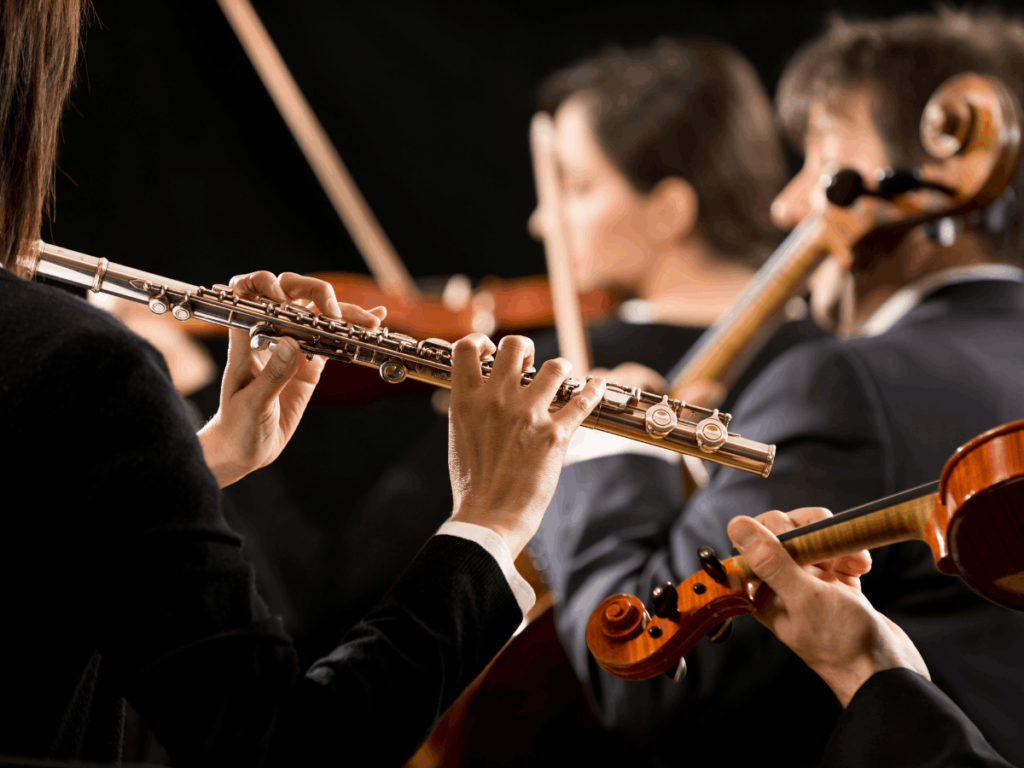
The Woodwind Section is one of the most critical sections in an orchestra. It consists of instruments that produce sound by blowing air through a tube or reed.
These woodwind family instruments include the flute, clarinet, oboe, and bassoon. The Woodwind Section is an essential part of the orchestra, and its instruments provide a unique sound that any other section cannot replicate.
Importance of Woodwind Instruments in Classical Music
Woodwind instruments have been an integral part of classical music for centuries. They create a wide range of sounds, from soft and delicate to bold and powerful.
The woodwind instruments are also capable of producing a variety of different tones, from bright and piercing to warm and mellow.
The woodwind section is crucial in creating the overall sound of the orchestra. It provides a unique texture and depth to the music that the other sections cannot achieve.
The instruments are often used to create a sense of movement and flow in the music, and they can also be used to create tension and drama.
In addition to their musical importance, woodwind instruments are also visually striking. Their elegant shapes and designs add to the overall aesthetic of the orchestra, and they’re often featured prominently on stage.
The Flute

The flute is a woodwind instrument that produces sound through the vibration of air passing through an embouchure hole and across the metal keys.
It’s a standard flute pitched in the key of C and is one of the oldest instruments.
Depending on the player’s skills and technique, the flute has a unique sound that can be soft, delicate, bright, and piercing.
The flute can be traced back to the classical period, where it was used in orchestras and chamber ensembles. It has undergone several changes over the years, with the addition of metal keys and improvements in its design and construction.
Role of the Flute in the Orchestra
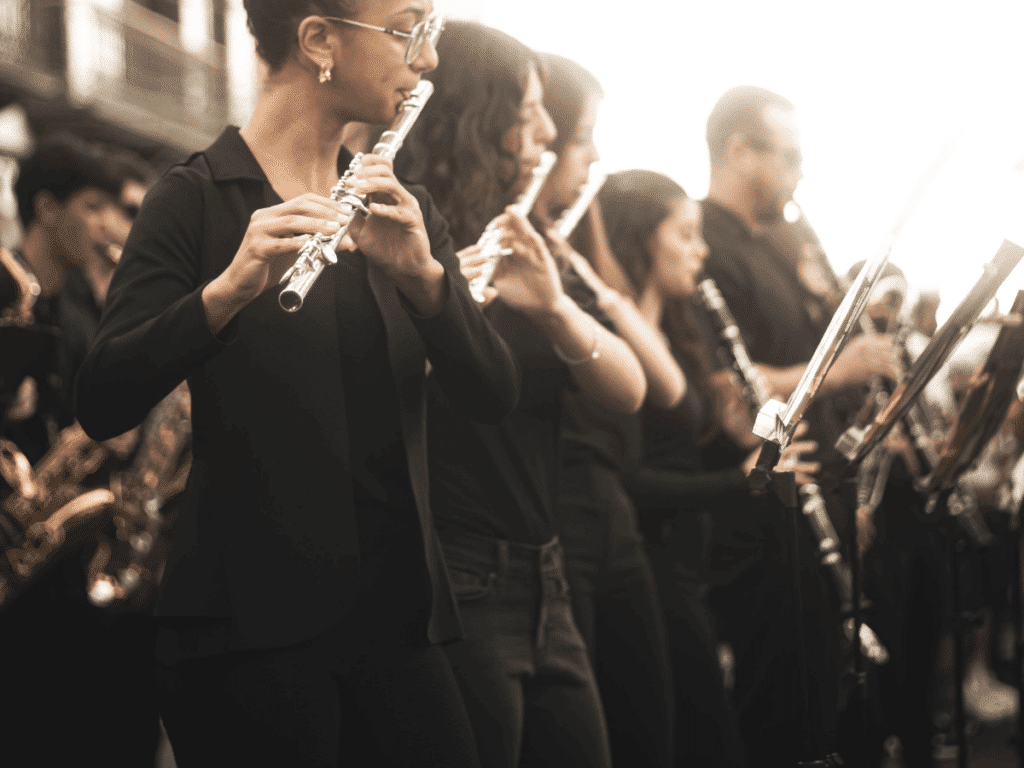
The flute plays an essential role in the woodwind section of the orchestra.
It’s the highest-pitched instrument in the woodwind section, adding a bright, shimmering quality to the orchestra’s sound.
The flute can create beautiful sustained melodies and blends perfectly with all instruments, providing background colour to foreground activity elsewhere in the orchestra.
The Clarinet
The clarinet is a woodwind instrument that uses a single reed attached to a mouthpiece to produce sound. It has a cylindrical tube with tone holes covered by keys, allowing the player to produce different notes.
The clarinet is commonly made of wood but can also be made of metal or plastic.
The most common type of clarinet is the Bb clarinet, but there are also other types, such as the bass and E-flat clarinet.
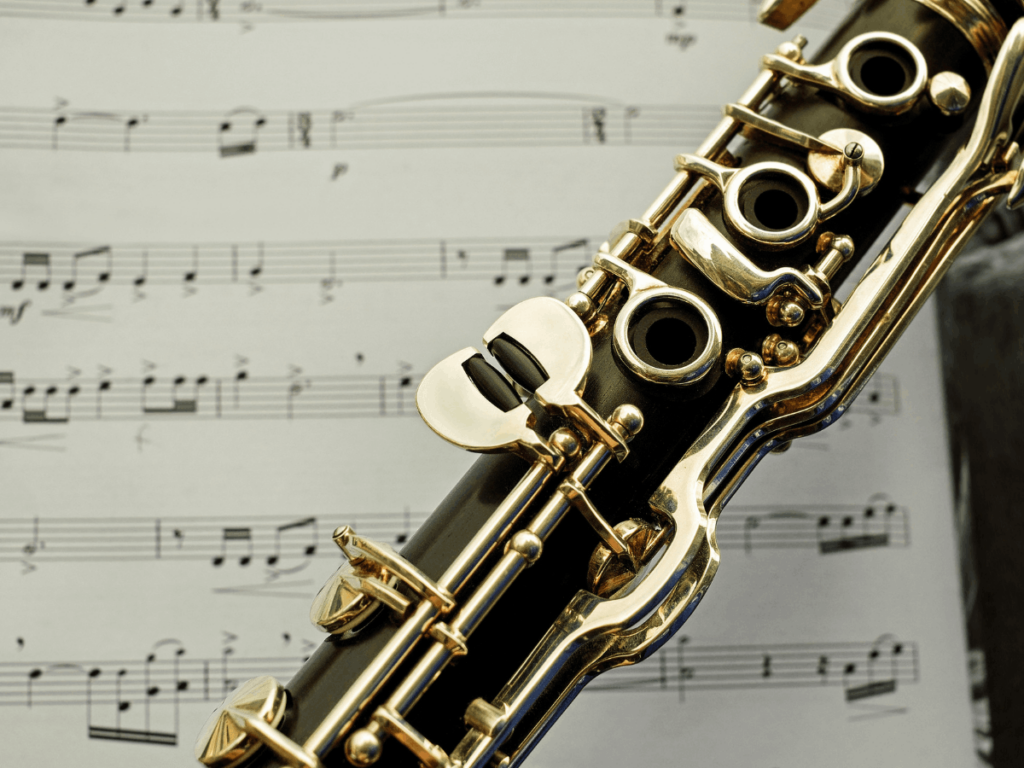
The clarinet was invented in the late 17th century by Johann Christoph Denner, a German instrument maker. The clarinet was originally used in military bands, but it soon found its way into orchestras.
Wolfgang Amadeus Mozart was one of the first composers to use the clarinet in his music, and it quickly became a popular instrument in classical music.
Role of the Clarinet in the Orchestra
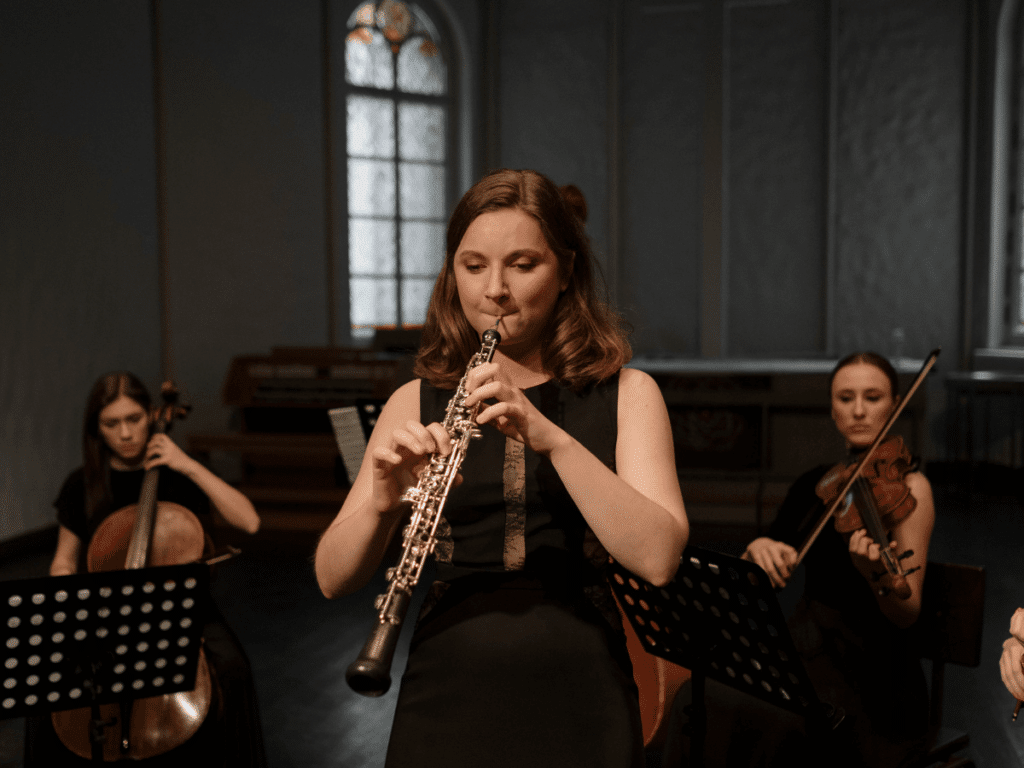
The clarinet is an essential instrument in the orchestra. It’s often used to play melodies and solos, but it can also provide harmony and support to other instruments.
The clarinet is versatile and can be used in various genres, including classical, jazz, and band music.
In the orchestra, the clarinet is usually positioned behind the first violins and is played by a single player. The clarinet can play in various registers, from the highest to the lowest notes, producing a wide range of sounds
The Oboe
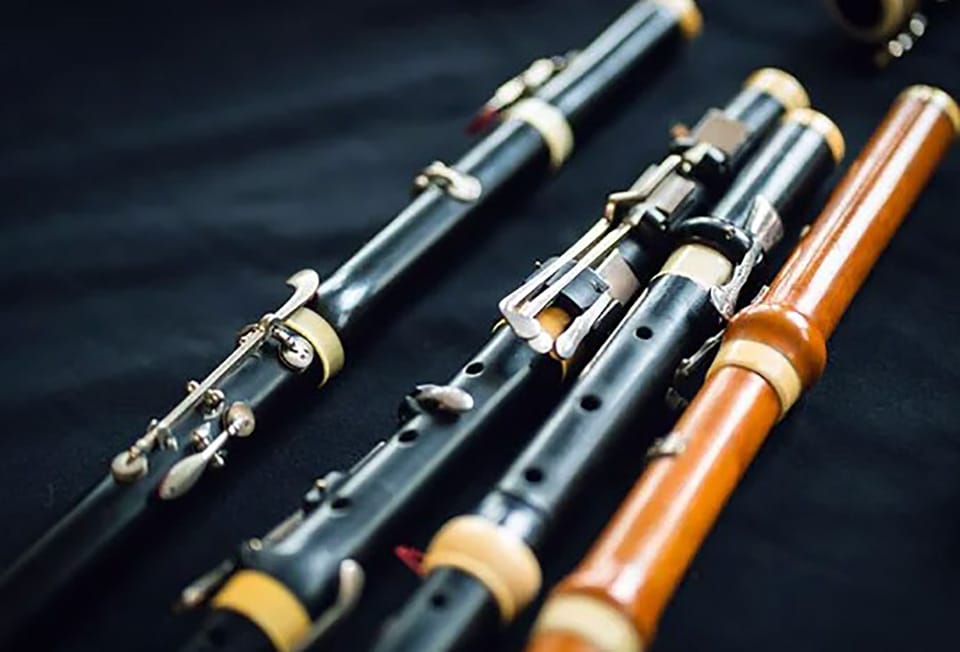
The oboe is a double-reed woodwind instrument known for its unique and expressive sound.
It’s wood or plastic and has a long, thin tube with metal keys. The player blows air through a double reed, which vibrates and produces sound.
The oboe is descended from an ancient instrument called a shawm and has been used in orchestras for centuries.
Role of the Oboe in the Orchestra
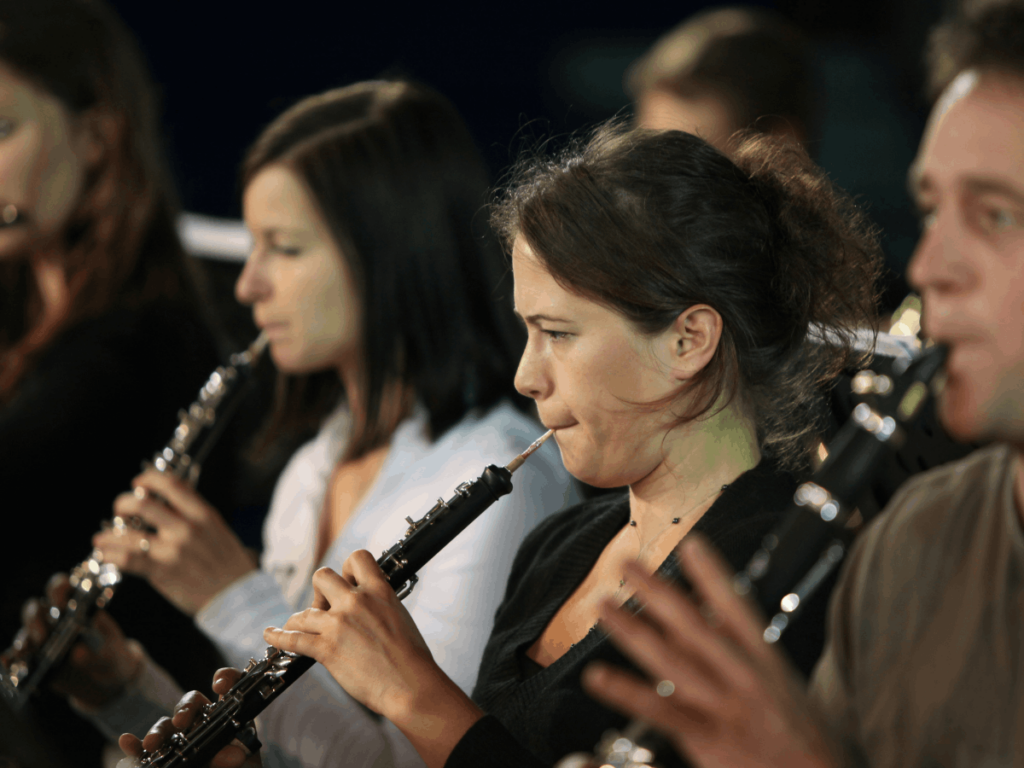
The oboe is an essential instrument in the orchestra and is often used to play the melody or a solo part.
It has a wide range of notes, from low to high, and can produce a rich, warm sound in the lower register and a bright, piercing sound in the higher register. The oboe is also used to provide harmony and support to other instruments in the orchestra.
The Bassoon
Description of the Bassoon and Its History

The bassoon is a woodwind instrument known for its distinctive tone, colour and versatility.
It’s played by blowing air into a double reed mouthpiece, which creates a unique, raspy sound. The bassoon is the lowest-sounding member of the woodwind family, often used to provide a solid bass foundation for orchestral pieces.
The bassoon has a long history, dating back to the Renaissance when it was used in dance music. It was later developed in the Baroque period and became a staple in the orchestra.
Role of the Bassoon in the Orchestra

The bassoon is essential in the orchestra, providing a solid bass foundation for the woodwind section.
It’s often used to play the bass line of the music, and it can also be used to provide a harmonic accompaniment to other instruments. The bassoon is also used to play solos, and it is known for its expressive and warm vibrato.
In the orchestra, the bassoon is typically played by a single musician responsible for playing all the bassoon parts in the music.
The bassoon player must be skilled in playing the instrument’s complex fingerings and have a good understanding of the music to ensure they play the correct notes at the right time.
Other Woodwind Instruments in the Orchestra
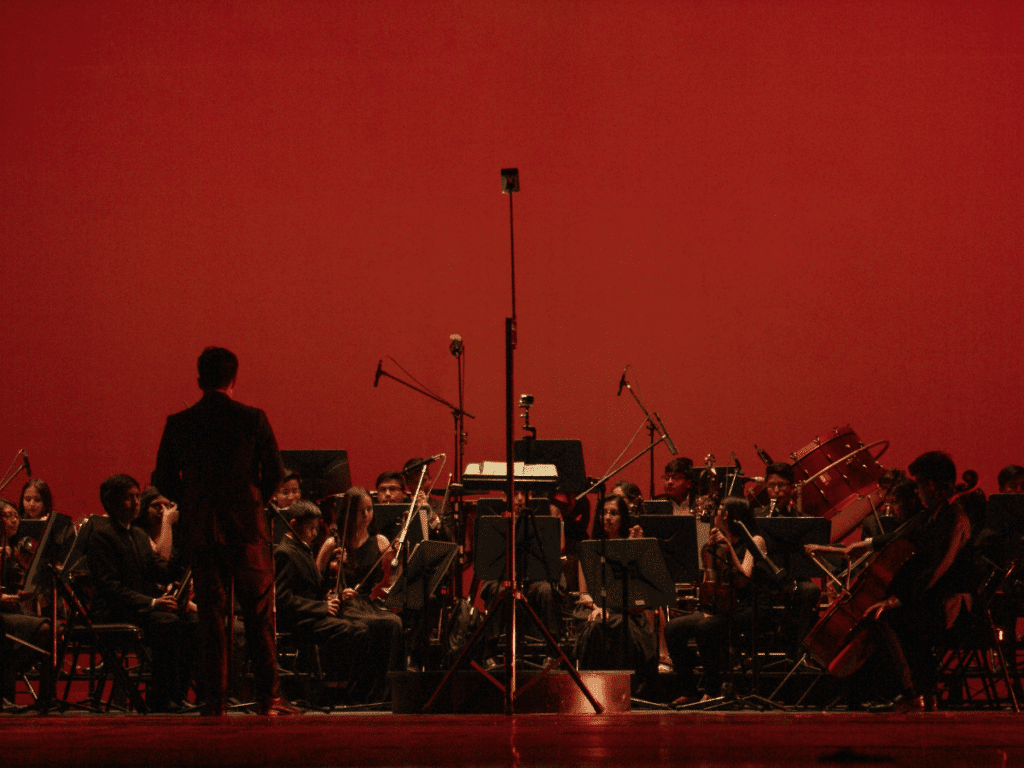
Apart from the four basic woodwind instruments, the orchestra also includes others.
These instruments are the piccolo, saxophone, English horn, and contrabassoon. They each play a unique role in the woodwind section of the orchestra.
Piccolo
The piccolo is a small, high-pitched woodwind instrument often used in the orchestra.
It’s a smaller version of the flute but with a higher range. The piccolo is typically used to add a bright and sparkling sound to the orchestra and is often featured in solos or as part of a larger ensemble.
Saxophone
The saxophone is a hybrid instrument that is considered a member of the woodwind family. Although it’s not traditionally a part of the orchestra, it has been used in modern and contemporary compositions to add a jazzy, improvisational feel to the music.
The saxophone is known for its smooth and jazzy sound and is often featured in jazz and pop music.
English Horn
The English horn is a double-reed instrument similar to the oboe but slightly larger and produces a lower, richer sound.
It has a warm and mellow sound often described as “bittersweet” or “haunting”. The English horn is typically used to play solos or to add a melancholic or romantic quality to the orchestra.
The contrabassoon is typically used to add a sense of depth and power to the orchestra and is often featured in the bass section of the woodwind ensemble.
Contrabassoon
The contrabassoon is the largest and lowest-pitched instrument in the woodwind family. It’s essentially a larger bassoon version and produces a deep, rich sound that can be felt in your bones.
The contrabassoon is typically used to add a sense of depth and power to the orchestra and is often featured in the bass section of the woodwind ensemble.
Our Recommended Woodwind Instruments
Yamaha YFL222 Student Model Flute
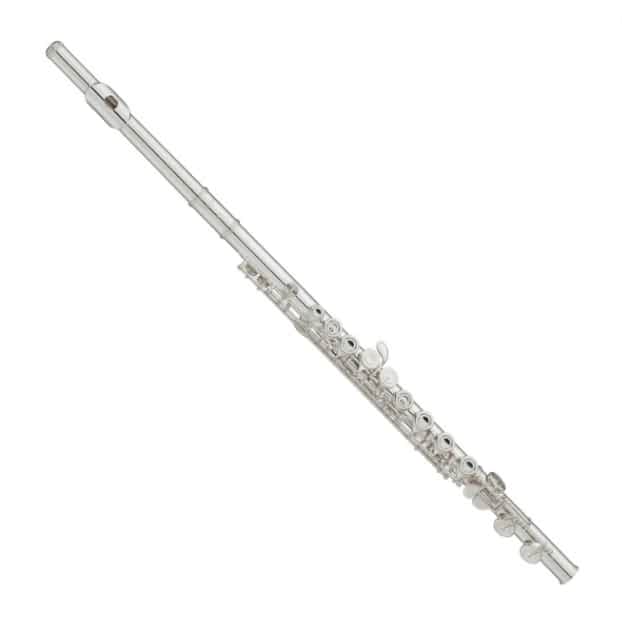
FEATURES: Durable nickel-silver body and headjoint
OTHER INFO: Split E mechanism for improved intonation and playing high notes
- High-quality instrument for beginners and students
- Produces clear and bright sound for developing good tone and technique
- Relatively expensive compared to other student flutes
When you click ‘Check Price’, you’ll see there are loads of great places to buy this item. Our personal favorite is Sweetwater for the US, and Thomann and Gear4Music for the UK & Europe.
They are the largest music retailers, with excellent customer service, competitive prices, really fast shipping, and the longest guarantees.
The professional musician who wrote this article combined many things,
from the product build, manufacturer’s reputation through to feedback
from other users, to create our famous TedScore™.
Yamaha YCL255S Clarinet

FEATURES: Matte finish ABS resin body for durability and resistance to wear, Adjustable thumb rest for a comfortable playing position
OTHER INFO: Projects well and responds easily
- High-quality instrument for beginners and students
- Produces a warm and round tone, making it suitable for a wide range of musical styles
- A bit basic for advanced players
- Somewhat expensive
When you click ‘Check Price’, you’ll see there are loads of great places to buy this item. Our personal favorite is Sweetwater for the US, and Thomann and Gear4Music for the UK & Europe.
They are the largest music retailers, with excellent customer service, competitive prices, really fast shipping, and the longest guarantees.
The professional musician who wrote this article combined many things,
from the product build, manufacturer’s reputation through to feedback
from other users, to create our famous TedScore™.
Yamaha YOB431B Intermediate Oboe

FEATURES: Grenadilla wood body for a rich and warm sound
OTHER INFO: Silver-plated keys for a durable and long-lasting finish
- High-quality instrument for intermediate and advanced players
- Produces a full and rich sound with excellent projection and intonation
- May be more expensive than other intermediate models
When you click ‘Check Price’, you’ll see there are loads of great places to buy this item. Our personal favorite is Sweetwater for the US, and Thomann and Gear4Music for the UK & Europe.
They are the largest music retailers, with excellent customer service, competitive prices, really fast shipping, and the longest guarantees.
The professional musician who wrote this article combined many things,
from the product build, manufacturer’s reputation through to feedback
from other users, to create our famous TedScore™.
Woodwind Instruments In The Orchestra
Summary
Yay! You’ve just unlocked the secret to the magical sound of orchestral music – the woodwind instruments! These instruments come together to create beautiful and harmonious music.
The common woodwind instruments we discussed are special because they’re versatile, like the clarinet being able to play in different registers and styles.
In classical music, the woodwind section is essential and responsible for creating some of the most memorable moments.
The flute has a bright and airy sound, while the oboe has a more reedy and nasal tone. The clarinet is like a chameleon, playing in different styles, while the bassoon provides a rich and resonant bass sound.
So, whether you’re a musician or music lover, the woodwind section will captivate and inspire you with its beautiful sound and versatility!
Wait, there’s more!!!
If the clarinet caught your attention, we have something for you!
Check out the article below to learn more about the clarinet, and you might find the next instrument to join you in your musical journey!
FAQ's
The wind instruments in an orchestra include the flute, clarinet, oboe, and bassoon. Other instruments from the woodwind family, from the highest pitch/smallest instrument to the lowest pitch/largest instrument, includes the piccolo, alto or bass flute, oboe, English horn, clarinet, E-flat clarinet, bass clarinet, bassoon, and contrabassoon.
The number of woodwind instruments in an orchestra can vary depending on the composition and arrangement. An orchestra typically has several woodwind instruments, including the flute, clarinet, oboe, and bassoon.
Yes, the orchestra includes woodwinds as one of its main sections. Woodwind instruments are essential to the orchestra, adding a unique and distinct sound that any other instrument family cannot replicate.
e composition and arrangement. An orchestra typically has several woodwind instruments, including the flute, clarinet, oboe, and bassoon.











This article provides an insightful overview of each woodwind instrument’s unique role within the orchestra. However, I would find it beneficial if future articles could delve into more technical aspects, such as the use of extended techniques by contemporary composers to achieve innovative sounds.
Oboes sound like ducks, change my mind lol
Maybe ducks sound like oboes ever thought of that?
While the article highlights several key aspects of the bassoon, I believe it overlooks the instrument’s versatility beyond classical music, such as its occasional use in jazz and pop music. Its unique timbre and range allow for a wide variety of applications.
Hey Sarah Nixon, really enjoyed this deep dive into the woodwind section! Curious about the flute’s evolution in orchestral music. How have its roles and repertoire expanded over the years? I’ve been playing the flute for a couple of years, and it’s fascinating to see its versatility across different music genres.
Love seeing fellow flutists here. The flute truly has an amazing range and depth in the orchestra!
Clara, that’s a great question! The flute’s role has indeed grown massively, especially from the Baroque period onwards, where it started to claim more solo pieces and complex parts in ensembles.